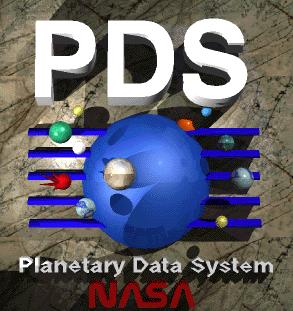|
|
|
This logo is at the top of all the Planetary Data Systems web pages at NASA. The first thing we notice is the sun and 11 planets. Something we are getting used to seeing. There is a lot of information put into this logo. You might notice that one of the planets (the 10th planet, a brown dwarf) is a fiery dark red planet that is streaking like a comet. Keep in mind this is not the Comet and Asteroid Data System, or the Moon Data System, but the Planetary Data System.
|
|
|
How about the 11th planet?
If you draw a line from the exact center of the blue planet in the bottom left, to the exact center of the green planet in the upper right, the line will go through the exact center of the sun! Indicating that these planets are exactly opposite of each other, with the sun in-between them. Now there are things done opposite to normal in this logo. For example, if you do a color invert, the blue sun will be yellow. Also, instead of casting shadows away from the sun, they are being cast towards it. This is good, because now, if you look closely at the distances from the planets to their shadows, what stands out, is that only in the case of the blue and the green ones, is the distance from the planet, to its shadows, exactly the same. Indicating that these two planets are the same distance from the sun.
|
|
|
WOW, NASA has had that in front of us for a while. However, there is still more that can be seen in this logo.
The lines that are going through the sun in the PDS logo have meaning. The center one, of course, is in the center. The next ones above and below, go through the sun at 19.5 degrees North and South, respectively. 
|
| |
As you can see, a tetrahedron inside of a sphere is always at 19.5 degrees. 19.47, to be exact. Nevertheless, what about the highest and lowest lines? There seems to be no connection until you extend a line from the center of the sun at 19.5 degrees, exiting the sun at one line and ends perfect at the end of the top and bottom lines.
This gives us a bigger circle, with the end points of the top and bottom lines at 19.5 degrees, and now all the planets and the sun will be inside of that circle. Nothing in this logo is random. Like the lines are tilted at about 33 degrees, and the brown dwarf is suppose to be 33 degrees off the plane of the ecliptic. The brown dwarf gives off a dark red light, and when moving into the inner solar system, the light will flare back, like wings, and will have the classical tail, like comets do. The appearance from Earth will be like a cross in the havens.
In the logo, THE SHADOW of the brown dwarf, (the one streaking like a comet) has wings and a tell, but is cleverly mostly covered up by a planet. Also, although there are no moons in the logo, next too the shadow of the green planet, (the one that is opposite of Earth) there is the shadow of two moons. Take a good look!
I suggest that, although I think that most everyone at NASA does not know there is another planet on the other side of the sun, or even about the brown dwarf. However, looking at the Planetary Data Systems logo, there must be at least one person there, that does know. (Probably more then just one.)
I think it would be a good idea if as many people as possible would go to the web site http://pds.jpl.nasa.gov and copied the logo to there pc, incase they decide to change the logo!
The 11th planet also seems to fit, or answer Richard Hoaglands, "Hyper dimensional Physics" model. Where he says, "We haven't discovered all the remaining members of the solar system yet!"
Go to http://www.enterprisemission.com/hyper2a.html to learn more about he's hyper dimensional physics model.
Addendum, October 2005
Unfortunately, and to my grate disappointment, I was right, and P.D.S. has changed it’s main logo! Just as I predicted.
However, in going through the archives, I was able to find the previous logo, so here is a link to one of the places I found the logo Remaining there, and as I have said before, it’s a good Idea to go there and cope the logo to your pc before they take it out of the archives as well.
http://pds-smallbodies.astro.umd.edu/
|
|
|


